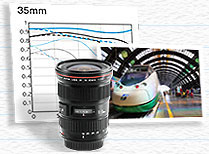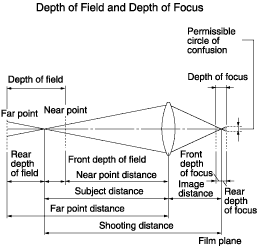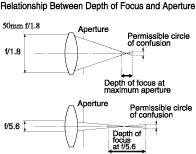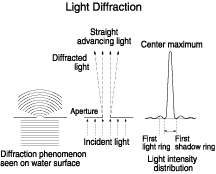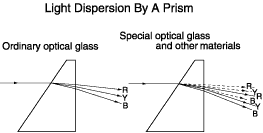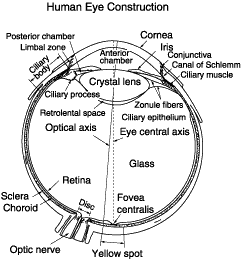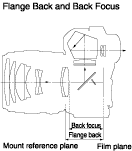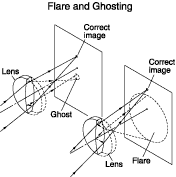 Depth of
focus Depth of
focus |
 |
|
The area in front of and behind the
focal plane in which the image can be photographed as a
sharp image. Depth of focus is the same on both sides of
the image plane (film plane) and can be determined by
multiplying the minimum circle of confusion by the F
number, regardless of the lens focal length. With modern
autofocus SLR cameras, focusing is performed by
detecting the state of focus in the image plane (film
plane) using a sensor which is both optically equivalent
(1:1 magnification) and positioned out of the film
plane, and automatically controlling the lens to bring
the subject image within the depth of focus area.
|
 Diffraction Diffraction |
 |
|
A phenomenon in which light waves
enter the shadow area of an object. With a photographic
lens, exposure is often adjusted by varying the size of
the lens' diaphragm (aperture) to adjust the amount of
light passing through the lens. Diffraction in a
photographic lens occurs at small apertures where the
diaphragm edges obstruct the straight-line path of
advancing light waves, causing light rays passing near
the edge of the diaphragm to bend around the edges as
they pass through the diaphragm. |
 Diffractive Optics Diffractive Optics
|
 |
|
Diffractive Optics, a revolutionary
new lens optical technology that permits super-telephoto
lenses that are significantly shorter and lighter than
previously possible, while simultaneously improving
optical performance by reducing chromatic aberrations
and even spherical aberrations. More
information |
 Diopter Diopter |
 |
|
The degree to which the light ray
bundles leaving the viewfinder converge or disperse. The
standard diopter of all EOS cameras is set at — 1 dpt.
This setting is designed to allow the finder image to
appear to be seen from a distance of 1m. Thus, if a
person cannot see the viewfinder image clearly, the
person should attach to the camera's eyepiece a dioptric
adjustment lens having a power which, when added to the
viewfinder's standard diopter, makes it possible to
easily see an object at one meter. The numerical values
printed on EOS dioptric adjustment lenses indicate the
total diopter obtained when the dioptric adjustment lens
is attached to the camera. |
 Dispersion Dispersion |
 |
|
A phenomenon whereby the optical
properties of a medium vary according to the wavelength
of light passing through the medium. When light enters a
lens or prism, the dispersion characteristics of the
lens or prism cause the index of refraction to vary
depending on the wavelength thus dispersing the light.
This is also sometimes referred to as color dispersion.
|
 Distance of
incidence Distance of
incidence |
 |
|
Distance from the optical axis of a
parallel ray entering a lens. |
 EMD (Electromagnetic
Diaphragm) EMD (Electromagnetic
Diaphragm) |
 |
|
Designed for use with the digital
data transfer of the EOS system made possible by the
fully electronic mount, every EF lens incorporates an
EMD that electronically controls aperture diameter. The
EMD is a diaphragm drive control actuator comprised of a
deformation stepping motor and diaphragm blade unit.
Features include the following. Because the system is
digitally controlled, its level of precision is far
higher than that of mechanical linkage systems. The
small rotor blades help deliver excellent start/stop
response and control. Elimination of linkage shock from
mechanical levers makes the system extremely quiet. The
fully electronic mount system makes it possible to close
down the aperture and confirm the setting and depth of
field at the touch of a button. The EMD mechanism
delivers superior durability and reliability. Its
diaphragm control components are integrated into a
single compact unit. And, the electronic control system
allows a high degree of freedom in designing unit
layout. |
 Extension amount Extension amount
|
 |
|
With a lens that moves the entire
optical system backward and forward when focusing, the
amount of lens movement necessary to focus a subject at
a limited distance from the infinity focus position.
|
 Extraordinary partial
dispersion Extraordinary partial
dispersion |
 |
|
The human eye can sense monochromatic
light wavelengths within the range of 400nm (purple) to
700nm (red). Within this range, the difference in index
of refraction between two different wavelengths is
called partial dispersion. Most ordinary optical
materials have similar partial dispersion
characteristics. However, partial dispersion
characteristics differ for some glass materials, such as
glass that exhibits larger partial dispersion at short
wavelengths, FK glass which features a small index of
refraction and low dispersion characteristics, fluorite,
and glass that exhibits larger partial dispersion at
long wavelengths. These types of glass are classified as
having extraordinary partial dispersion characteristics.
Glass with this property is used in apochromatic lenses
to compensate chromatic aberration. |
 Eyesight, visual
acuity Eyesight, visual
acuity |
 |
|
The ability of the eye to distinguish
details of an object's shape. Expressed as a numerical
value which indicates the inverse of the minimum visual
angle at which the eye can clearly distinguish two
points or lines, i.e. the resolution of the eye in
reference to a resolution of 1'. (Ratio with a
resolution of 1' assumed as 1.) |
 Far-sightedness Far-sightedness |
 |
|
The eye condition in which the image
of an infinitely distant point is formed to the retina
when the eye is in the accommodation rest state.
|
 Five aberrations of
Seidel Five aberrations of
Seidel |
 |
|
In 1856, a German named Seidel
determined through analysis the existence of five lens
aberations which occur with monochromatic (single
wavelength) light. These are called the five aberrations
of Seidel. |
 Flange back Flange back
|
 |
|
Distance from the camera's lens mount
reference surface to the focal plane (film plane). In
the EOS system, flange back is set at 44.00 mm on all
cameras. Flange back is also referred to as flange-focal
distance. |
 Flare Flare |
 |
|
Light reflected from lens surfaces,
the inside of the lens barrel and the inner walls of the
camera's mirror box can reach the film and fog part or
all of the image area, degrading image sharpness. These
harmful reflections are called flare. Although flare can
be reduced to a large extent by coating the lens
surfaces and using anti-reflection measures in the lens
barrel and camera, flare cannot be completely eliminated
for all subject conditions. It is therefore desirable to
use an appropriate lens hood whenever possible. The term
"flare" is also used when referring to the effects of
blurring and halo caused by spherical and comatic
aberration. |
 Floating system Floating system
|
 |
|
General photographic lenses are
designed to achieve an optimum balance of aberration
compensation at only one commonly-used shooting
distance. Thus, although aberrations are well
compensated at the reference shooting distance,
aberrations increase at other shooting distances
(especially at close shooting distances) and cause image
degradation. To prevent this from happening, a floating
system is used which varies the interval between certain
lens elements in accordance with the extension amount.
This method is also referred to as a close-distance
aberration compensation mechanism. |
 Fluorite Fluorite |
 |
|
Fluorite has extremely low indexes of
refraction and dispersion compared to optical glass and
features special partial dispersion characteristics
(extraordinary partial dispersion), enabling virtually
ideal correction of chromatic aberrations when combined
with optical glass. This fact has long been known, and
in 1880 natural fluorite was already in practical use in
the apochromatic objective lenses of microscopes.
However, since natural fluorite exists only in small
pieces, it cannot be used practically in photographic
lenses. In answer to this problem, Canon in 1968
succeeded in establishing production technology for
manufacturing large artificial crystals. Thus opening
the door for fluorite use in photographic lenses.
|
 Focal length Focal length
|
 |
|
When parallel light rays enter the
lens parallel to the optical axis, the distance along
the optical axis from the lens' second principal point
(rear principal point) to the focal point is called the
focal length. In simpler terms, the focal length of a
lens is the distance along the optical axis from the
lens' second principal point to the film plane when the
lens is focused at infinity. |
 Focal point,
focus Focal point,
focus |
 |
|
When light rays enter a convex lens
parallel to the optical axis, an ideal lens will
converge all the light rays to a single point from which
the rays again fan out in a cone shape. This point at
which all rays converge is called the focal point. A
familiar example of this is when a magnifying glass is
used to focus the rays of the sun to a small circle on a
piece of paper or other surface; the point at which the
circle is smallest is the focal point. In optical
terminology, a focal point is further classified as
being the rear or image-side focal point if it is the
point at which light rays from the subject converge on
the film plane side of the lens. It is the front or
object-side focal point if it is the point at which
light rays entering the lens parallel to the optical
axis from the film plane side converge on the object
side of the lens. |
 Focus Preset Focus Preset
|
 |
|
A feature on the Image Stabilized
super-telephoto EF lenses. The photographer can focus
upon a subject and memorize that focus setting, and
later return instantly to it with a brief turn of the
metal "playback" ring on the lens' barrel. |
 Fraunhofer's lines Fraunhofer's lines
|
 |
|
Absorption lines discovered in 1814
by a German physicist named Fraunhofer (1787-1826),
comprising the absorption spectrum present in the
continuous spectrum of light emitted from the sun
created by the effect of gases in the sun's and earth's
atmospheres. Since each line is located at a fixed
wavelength, the lines are used for reference in regard
to the color (wavelength) characteristics of optical
glass. The index of refraction of optical glass is
measured based on nine wavelengths selected from among
Fraunhofer's lines. In lens design, calculations for
correcting chromatic aberrations are also based on these
wavelengths. |
 Fresnel lens Fresnel lens
|
 |
|
A type of converging lens, formed by
finely dividing the convex surface of a flat convex lens
into many concentric circle-shaped ring lenses and
combining them to extremely reduce the thickness of the
lens while retaining its function as convex lens. In an
SLR, to efficiently direct peripheral diffused light to
the eyepiece, the side opposite the matte surface of the
focusing screen is formed as a fresnel lens with a
0.05mm pitch. Fresnel lenses are also commonly used in
flash units, indicated by the concentric circular lines
visible on the white diffusion screen covering the flash
tube. The projection lens used to project light from a
lighthouse is an example of a giant fresnel lens.
|
 Front group linear
extension Front group linear
extension |
 |
|
The rear group remains fixed and only
the front group moves straight backward and forward
during focusing. Examples of front group linear
extension lenses include the EF 50mm f/2.5 Compact Macro
and the EF 85mm f/1.2L USM. |
 Front group
rotational extension Front group
rotational extension |
 |
|
The lens barrel section holding the
front lens group rotates to move the front group
backward and forward during focusing. This type of
focusing is used only in zoom lenses and is not found in
single focal length lenses. Representative examples of
lenses using this method are the EF 35-80mm f/4-5.6 USM
and
EF 100-300mm f/5.6L. Since the filter attachment
ring and hood rotate with the lens during focusing, care
must be taken when shooting through a glass window to
make sure the end of the lens does not contact the
glass. |
 Full-time manual
focusing Full-time manual
focusing |
 |
|
A system that allows the photographer
to turn the lens' manual focusing ring and instantly
override autofocus – while the lens' AF/MF switch is
still in the autofocus mode. More than half of Canon's
EF lenses with Ultrasonic Motors have this feature.
|
 Fully electronic mount
system Fully electronic mount
system |
 |
|
Development of the EOS system began
with Canon's own "body range-finding and in-lens motor
drive system" and "fully electronic mount system",
technologies that were developed in 1985 to quickly
respond to the trend towards full-fledged autofocusing
SLR cameras. The EOS system centers on the camera body
and consists of various components including Canon's
full line of EF lenses, Speedlite flash units, and
interchangeable backs. The three main features of the
EOS system are as follows.
 |
| 1. |
Multi-processor system
control
A
high-speed processor in the camera body interfaces
with processors in the lens and the flash units,
(for high-speed data processing, calculation and
communications), to carry out high level systems
control. |
| 2. |
Multi-actuator
system
The ideal
actuator for each drive unit is located near the
drive unit to form a multi-actuator system that
realizes high-level automation, high efficiency,
and high performance. |
| 3. |
Fully
electronic interface
All data transfer between the
camera body, lens, flash and interchangeable back
is handled electronically. This not only increases
the functionality of the current system, but also
creates a network ready to accept future system
developments. | |
 |
  |
 |
![]()
